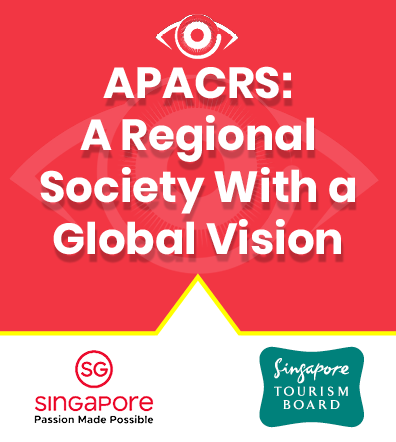Eyeworld Weekly Update |
Volume 20, Number 24 |
26 June 2015 |
- In memoriam: Robert M. Sinskey, MD
- Sustained release allergic conjunctivtis depot begins phase 3 enrollment
- FDA recommends brilliant blue G for compounding
- Optina shows promise in DME study
In memoriam: Robert M. Sinskey, MD
Robert M. Sinskey, MD, an innovator in cataract surgery and past president of ASCRS, has died.
Dr. Sinskey served as guest faculty and surgeon in more than 100 symposia and had more than 200 speaking engagements around the world. He published more than 30 journal articles and textbook chapters, as well as a revised monograph on phacoemulsification. Together with Richard Kratz, MD, Dr. Sinskey trained more than 3,500 ophthalmologists in the phaco procedure in the 1970s and 80s.
Dr. Sinskey patented the internationally popular modified J-loop IOL and invented several surgical instruments. He pioneered the use of low-power IOLs and the use of IOLs in infants and children with cataracts.
Dr. Sinskey served as medical director emeritus of the Southern California Lions Eye Institute, clinical professor of ophthalmology at the Jules Stein Eye Institute at UCLA, and on the staff of St. John's Health Center in Santa Monica, Calif. He was a board member of the ASCRS Foundation and the driving force behind the foundation's Robert M. Sinskey Eye Institute in Addis Ababa, Ethiopia, which has treated more than 100,000 patients since its founding.
Sustained release allergic conjunctivtis depot begins phase 3 enrollment
A phase 3 study to evaluate the safety and efficacy of Dextenza (sustained release dexamethasone, 0.4 mg) for the treatment of allergic conjunctivitis has begun enrollment, developer Ocular Therapeutix (Bedford, Mass.) said in a press release.
The bioresorbable intracanalicular depot is designed to release dexamethasone to the ocular surface for up 30 days after physician administration.
The U.S.-based multicenter, randomized, parallel-arm, double-masked, vehicle-controlled study is enrolling subjects who exhibit chronic signs and symptoms of allergic conjunctivitis, and is the first of two phase 3 studies. In this study, the comparator is a placebo punctum plug. The study will use a series of 3 successive allergen challenges over a 30-day period. Dextenza or placebo will be administered 48 to 72 hours after final confirmatory exposure to the allergen, and the primary endpoints to be evaluated are ocular itching and conjunctival redness at day 7 following insertion. The secondary efficacy measures for both itching and redness are measured at day 14 following insertion and on days 27-30 post-insertion.
FDA recommends brilliant blue G for compounding
Members of the Food and Drug Administration's Center for Drug Evaluation and Research Pharmacy Compounding Advisory Committee recommended that brilliant blue G be included on a list of bulk drug substances that may be used for compounding.
While concerns about sterility were raised, the safety of the compound (in use for about a decade for staining for visualization of ophthalmic procedures) was not questioned; in some procedures the compound has been more effective as a stain than approved alternatives, said Wiley Chambers, MD, supervisory medical officer, Division of Transplant and Ophthalmology Products, FDA.
Optina shows promise in DME study
Oral treatment with Optina (low-dose danazol) in patients with diabetic macular edema (DME) has shown a "reversal of pathological changes and a synergistic effect with other medication," developer Ampio Pharmaceuticals (Englewood, Colo.) said in a press release.
Optina-treated patients had changes that included the reversal of complications such as cystic lesions and subretinal fluid. Additionally, analysis revealed that 69% of the patients receiving a standard of care medication that manages kidney-induced high blood pressure (including angiotensin converting enzyme inhibitors or angiotensin receptor blockers) showed a 6-letter improvement compared to placebo (p=0.01), regardless of whether or not they previously had antivascular endothelial growth factor eye injections. There was a significant 34 micron reduction in central retinal thickness over placebo (p=0.02); 60% of these eyes showed a restoration of at least 1 line of vision compared to only 27% of placebo (p=0.05).
RESEARCH BRIEFS
- Comparison of 2 microincision IOLs indicated a statistically significant difference in posterior capsule opacification (PCO) and Nd:YAG capsulotomy rates, with very high Nd:YAG rates 4 years after surgery in the hydrophobic group compared to a hydrophilic group. S.M. Schriefl and colleagues prospectively randomized 60 patients (120 eyes) to receive a Y-60H 3-piece hydrophobic IOL (hydrophobic group) in 1 eye and an MI60 1-piece hydrophilic IOL (hydrophilic group) in the contralateral eye during simultaneous bilateral cataract surgery. Objective PCO was significantly higher in the hydrophobic group than in the hydrophilic group before capsulotomy 2 years after cataract surgery (P=.031). At the 4-year follow-up, the hydrophobic group had a statistically significantly higher Nd:YAG rate than the hydrophilic group (77% versus 50%; P=.012). The study is published in the Journal of Cataract & Refractive Surgery.
- Cataract surgery leads to vision improvement and does not appear to contribute to worsening of wet age-related macular degeneration (AMD), according to a new study published in the American Journal of Ophthalmology. S.S. Saraf and colleagues retrospectively reviewed the performance of consecutive patients with wet AMD who underwent cataract surgery at the midpoint of a 1-year study window (n=40). A control arm included wet AMD eyes treated with antivascular endothelial growth factor (VEGF) injections that did not undergo cataract surgery for a 1-year period (n=43). Best corrected visual acuity was equivalent in the first half of the study, and became significantly better in the surgical group versus the nonsurgical group (0.23±0.65 versus 0.11±0.59 logMAR improvement; p=0.049). There was no change in the number of injections given 6 months before versus after the midpoint in the surgical group (p=0.921). The mean central retinal thickness became greater in post-surgical eyes compared to nonsurgical eyes (265.4±98.4 μm versus 216.4±58.3 μm; p=0.011). Surgical eyes were more likely to develop new or worse cystoid changes after the study midpoint (13 surgical eyes [54.2%] versus 9 nonsurgical eyes [28.1%], p=0.048).
- Although clinical outcomes and corneal endothelial cell loss were similar in both groups, tamponade with 20% sulfur hexafluoride (SF6) yielded a significantly lower incidence of graft detachments that may warrant its routine use in Descemet's membrane endothelial keratoplasty (DMEK) when compared to 100% air as a tamponade, according to Jose L. Guell, MD, and colleagues. They retrospectively evaluated pseudophakic patients with Fuchs' endothelial dystrophy or pseudophakic bullous keratopathy that underwent DMEK using either 20% SF6 (group 1; 42 eyes) or 100% air (group 2; 39 eyes) tamponade between April 2010 and August 2011. A bimanual infusion technique was used to introduce and position the donor endothelium-Descemet's membrane graft tissue. Three years after surgery, mean corrected distance visual acuity (CDVA) improved from 0.48±0.45 logMAR to 0.04±0.23 in group 1 (P<0.001) and from 0.67±0.45 logMAR to 0.09±0.13 logMAR in group 2 (P<0.001). Mean preoperative central endothelial cell count and at last follow-up were: group 1, 2525±338 cells/mm2 and 1758±398 cells/mm2 (mean cell loss, 30±11%; P=0.008); and group 2, 2492±204 cells/mm2 and 1678±373 cells/mm2 (mean cell loss, 32±13%; P=0.008). Endothelial cell loss was similar in both groups (P=0.65). Intracameral air reinjection was needed in 1 patient in group 1 (2.38%) and in 5 patients in group 2 (12.8%). The rebubbling rate was significantly higher in group 2 (P=0.004). No episodes of immunologic graft rejection were documented. The study is published online ahead of print in Ophthalmology.
 Licensed Publications |
Licensed through ASCRS American Society of Cataract and Refractive Surgery, 4000 Legato Road, Suite 700, Fairfax, VA 22033-4003, USA.
All rights reserved. The ideas and opinions expressed in EyeWorld Asia-Pacific Weekly News do not necessarily reflect those of the ASCRS�ASOA or APACRS. Mention of products or services does not constitute an endorsement by the ASCRS�ASOA or APACRS. Copyright 2008, EyeWorld News Service, a division of ASCRS Media. |



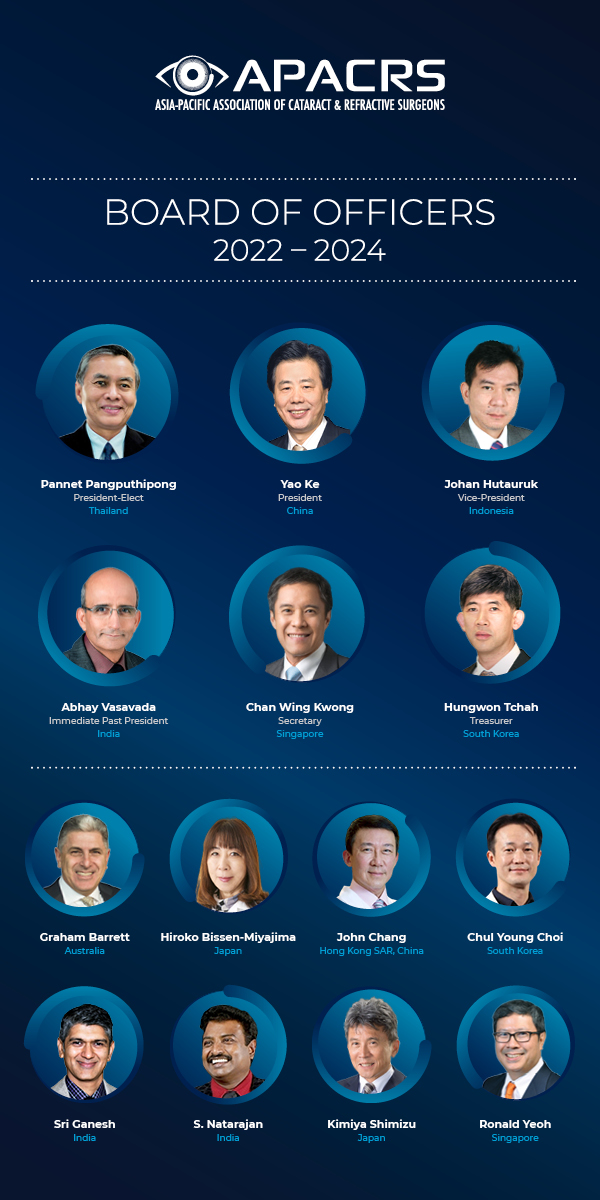
 EyeSustain Update
EyeSustain Update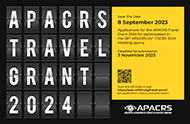 2024 APACRS TRAVEL GRANT
2024 APACRS TRAVEL GRANT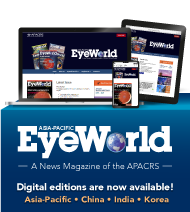 Digital EyeWorld
Digital EyeWorld VOL. 39 (2023), ISSUE 3
VOL. 39 (2023), ISSUE 3  Membership Information
Membership Information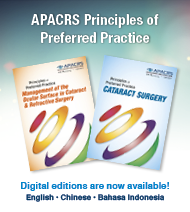 APACRS Principles of Preferred Practice
APACRS Principles of Preferred Practice